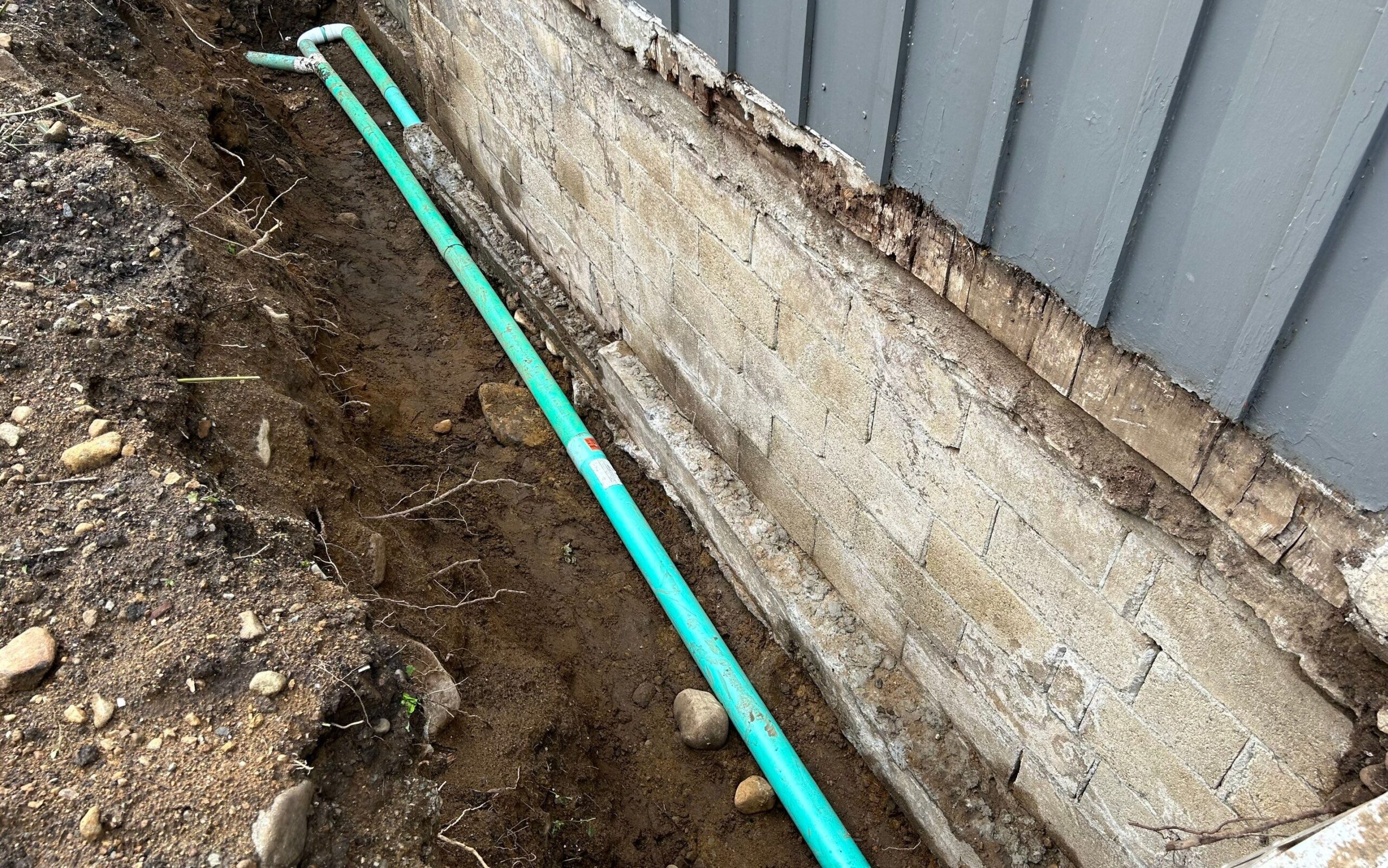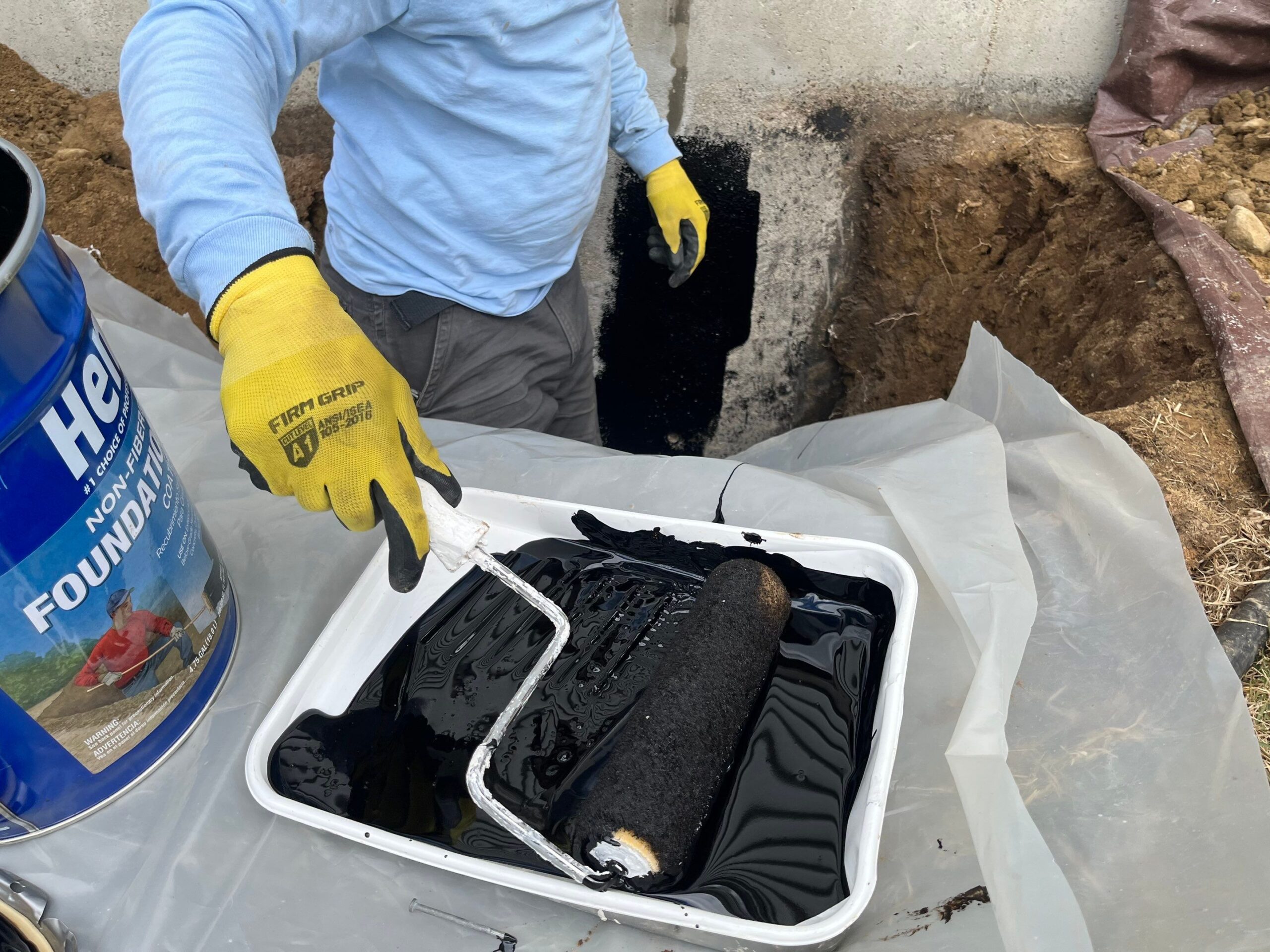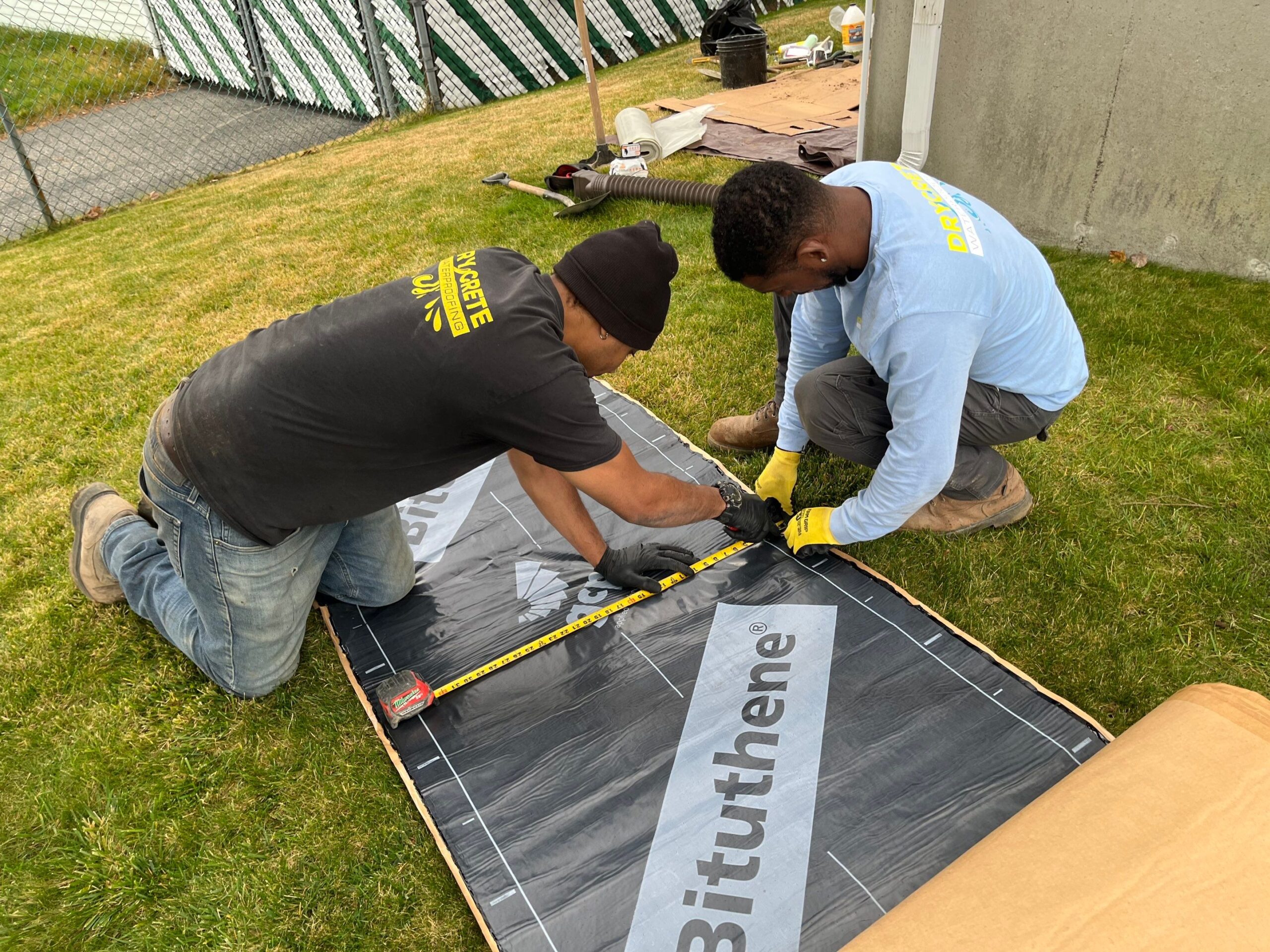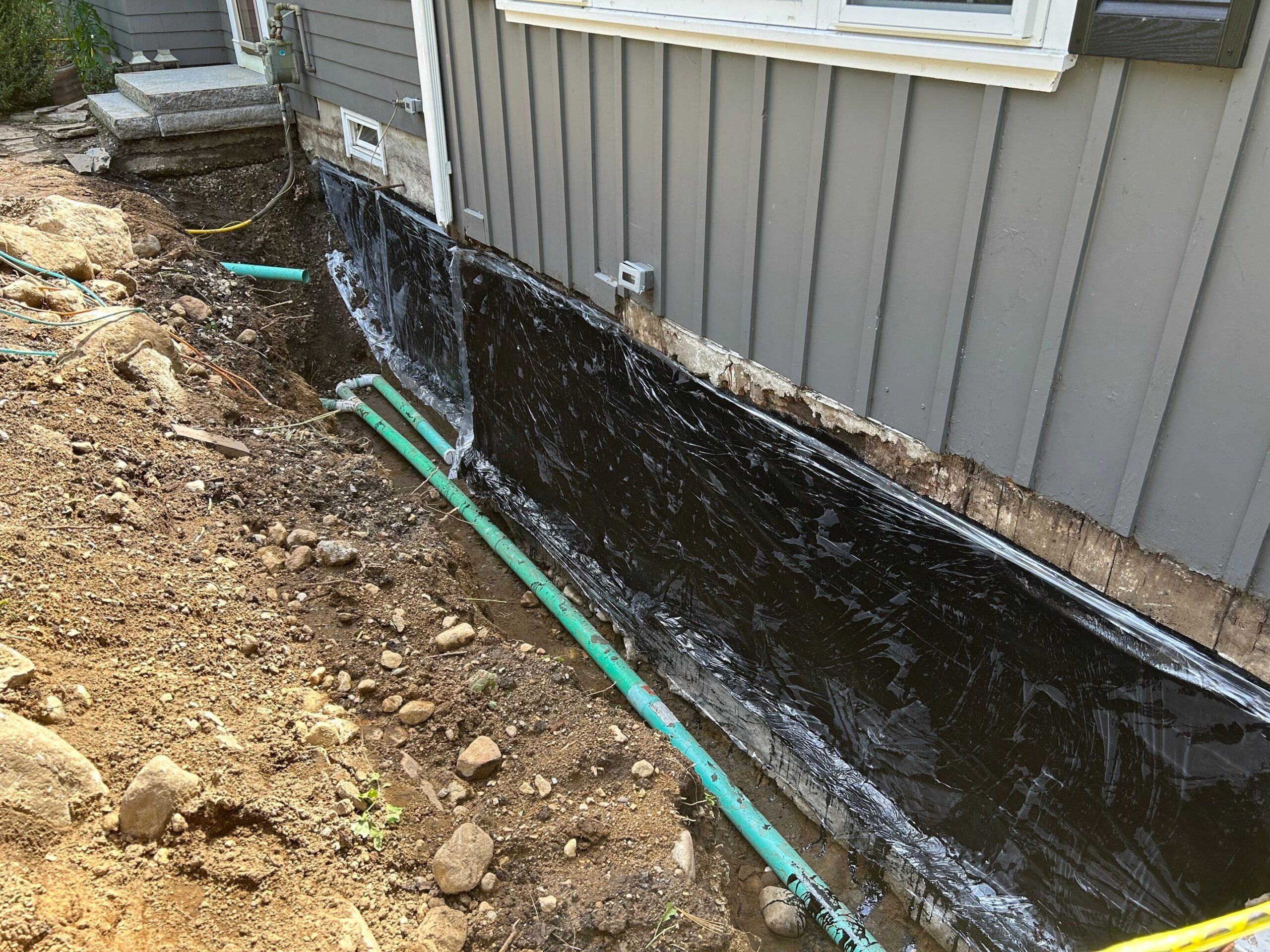There are a variety of reasons to waterproof house foundations from the outside. If you have a finished basement you want to protect from water intrusion, but you don’t want to demo, then you may want to consider exterior waterproofing. If you are purchasing an old home with fieldstone foundation or cinderblock you may need to waterproof your foundation from the outside. There is no shortage of reasons that a person would look to their exterior for basement waterproofing, so today we’re going to explain exactly how you do that.
Step 1: Excavate the Soil Around the Perimeter of your Foundation

The first step in waterproofing your foundation from the outside is to excavate the soil around your foundation walls. Depending on a variety of factors such as site constraints, soil stability, weather conditions, and scope of the project, the soil will be excavated in sections or all at once.
For exterior waterproofing it is important to expose your foundation wall all the way down to the base of the footing.
Step 2: Clean and Prep Your Foundation Walls

Once your foundation walls are exposed, it’s time to clean and prep them for waterproofing. This is the most important step in the process because proper preparation is essential for excellent exterior waterproofing. Cleaning your foundation walls helps with:
- Adhesion: The next steps rely on a surface free of dirt and debris. A clean surface allows the waterproofing materials to properly adhere to your foundation walls.
- Inspection: Cleaning your exterior foundation wall allows for a thorough inspection. It’s important to identify any damage to your foundation walls that could allow for water intrusion.
Step 3: Fix Damage to Your Foundation Walls

Another important step of waterproofing house foundations from the outside is repairing damage to the walls. This will look slightly different depending on what type of foundation walls you have.
Fieldstone or Cinderblock Foundation:
Here in New England, fieldstone foundations are common in older homes. These types of foundations, along with cinderblock foundations, require special care as the mortar joints can deteriorate over time.
Once the walls are cleared of debris your exterior foundation walls should be repointed, meaning reapplying mortar to the space between the blocks or stones. For fieldstone foundations you may have to patch holes in the foundation walls to create a nice flat surface for the waterproofing material.
Poured Concrete Foundation:
If you have a poured concrete foundation, you’ll need to have any cracks, honeycombing, or other defects repaired before proceeding. These issues can worsen over time and especially in climates that experience a freeze-thaw cycle.
Step 4: Apply a Waterproofing Membrane to the Outside of the Foundation
Once the surface is repaired and prepped a waterproof membrane should be applied to the outside of your home’s foundation. This membrane could be a liquid-applied coating, a sheet membrane, dimple board, or a combination of the three.
The reason we apply a waterproof membrane to your exterior foundation is because concrete is porous. When wet soil is pressed up against your foundation walls the concrete will soak up the moisture like a sponge, causing moisture issues on the inside of your basement.

A liquid applied waterproofing membrane is designed to create a barrier between the moist soil and your concrete foundation. This stops the wicking effect and prevents moisture related damage to your foundation walls.

Sheet membranes are typically made of flexible, waterproof materials like rubber or asphalt based compounds and accomplishes the same goal as liquid membranes but in a more robust way.

Dimpled board is designed to allow air flow between your concrete wall and the soil surrounding. Water is able to run down the membrane into a drain system and way from your home.
Step 5: Install Window Wells
If you have basement windows, then you should install new window wells. Basement window wells are a common cause of basement leaks and properly installed window wells can go a long way in preventing that. An appropriately sized window well should be secured to your foundation wall by bolting it in place.
Step 6: Install a Drain System
If you do not already have a drain system installed then now is the time to do so. You may have an interior French drain system or exterior French drain system. Either way it is designed to collect water that is running down your waterproofing membrane and give it a path to travel away from your home.
Your drain system is installed in a trench filled with crushed stone and lined with filter fabric to prevent debris from clogging up the system.
Step 7: Backfill The Soil Around Your Foundation
Once the membrane and drain system is installed, it’s time to carefully backfill the soil around your home’s foundation. During this process precautions are taken not to damage your newly installed waterproofing membrane, drain system, and window wells.
Drainage material such as crushed stone is used to backfill around and under your window well. The drainage material should extend all the way down to your footing so water will not have a chance to accumulate in the well. 6 to 8 inches of space should be left from the top of the drainage material to the bottom of the windowsill. A proper window well cover should be installed.
Step 8: Landscaping and Downspout Extensions
The final and often overlooked step to waterproof house foundations from the outside is landscaping and downspout extensions. There are a variety of landscaping techniques you can use to encourage proper water runoff and absorption but the most important is grading. Properly grading the soil around your home means sloping your yard so that water runs away from your foundation rather than towards it.
Gutter downspouts are another common waterproofing issue in homes. If your downspout is dumping water right near your foundation that can cause issues with pooling water and excessive moisture near your foundation. Directing downspouts away from your home with extensions will greatly improve your water management efforts.
In Conclusion:
To effectively waterproof house foundations from the outside is a comprehensive process that involves several critical steps. From excavating the soil around the foundation and meticulously preparing the walls, to repairing any damage and applying a suitable waterproofing membrane, each stage plays a vital role in ensuring long-term protection against water intrusion.
Additionally, installing window wells and a proper drainage system, followed by careful backfilling and strategic landscaping, are essential to maintain the integrity of the waterproofing. This process not only safeguards your basement against moisture and related damage but also enhances the overall health and longevity of your home’s structure.

